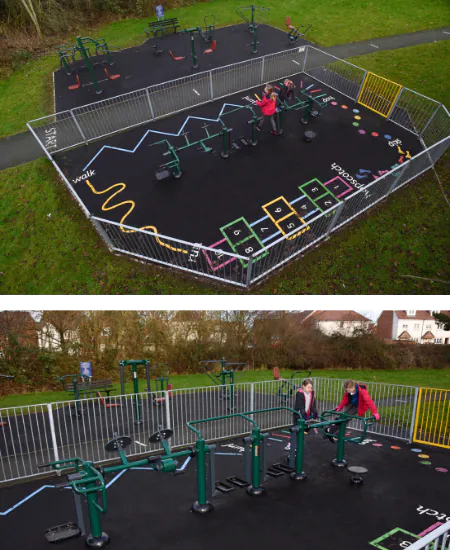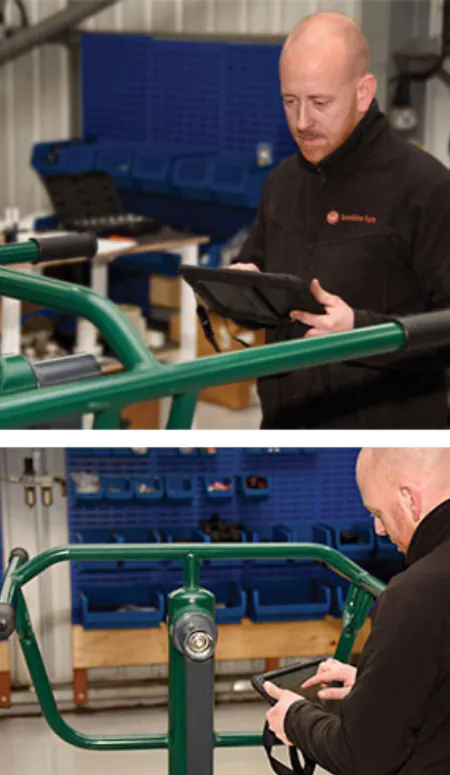Safety


Upholding Safety Standards at Sunshine Gym
This document is informed by our specialised experience in conjunction with elements of the European Standard BS EN 16630:2015 Permanently installed outdoor fitness equipment – Safety requirements and test methods.
Before discussing this safety standard, readers need to be made aware that this standard applies to equipment which is ‘intended for youths and adults or users having an overall height greater than 1400mm to promote fitness by using the equipment to exercise’. All Sunshine Gym outdoor fitness equipment which is designed for users greater than 1400mm in height has been independently tested and assessed to the BS EN 16630:2015 standard. Certificates are available upon request.
For the purpose of creating safety information which is applicable to the use of outdoor gym equipment by children, we have applied our own independent knowledge to appropriate sections of BS EN 16630:2015.
Safety Standards for Outdoor Fitness Equipment.
All Sunshine Gym outdoor fitness equipment which is designed for users greater than 1400mm in height has been independently tested and assessed to the BS EN 16630:2015 safety standard. Certificates are available upon request.
Due to no such standard existing for equipment which caters to children under 1400mm in height, Sunshine Gym test each of our Children’s range to the same high standards as the adults’. For the purpose of creating safety information which is applicable to the use of outdoor gym equipment by children, we have applied our own independent knowledge to appropriate sections of BS EN 16630:2015.
Placement of Equipment Near Playgrounds
BS EN 16630:2015 specifically states that ‘Equipment covered in this standard is not playground equipment for children’. Therefore, we and other experts within the play industry are in agreement that children or users who are less than 1400mm in height should not be using Adult Outdoor Fitness Equipment. For these reasons, the standard specifies that the ‘equipment is not intended for installation in the immediate vicinity of children’s playgrounds’.
Although this can be achieved in most circumstances, it is not always possible. Therefore, the standard does allow for ‘fencing or other metal structures’ to clearly separate the children’s playground equipment from the fitness equipment, which is designed specifically for users whose height exceeds 1400mm.
It is vital that easy-to-read signage is installed in a visible location; signs should inform the public of the appropriate use of the fitness equipment.
Please also note, any public space which has both adults' and children's outdoor fitness equipment, should also have the appropriate fencing, and signage.


Safety and Children's Outdoor Fitness Equipment
As already stated, the BS EN 16630:2015 standard specifically states that the equipment it covers ‘is not playground equipment for children’. Therefore, we and other experts within the play industry are in agreement that children or users who are less than 1400mm in height should not be using Adult Outdoor Fitness Equipment.
Sunshine Gym has developed a range of outdoor fitness equipment specifically designed for children or users below 1.4m in height; the BS EN 16630:2015 standard (for “Adult” equipment) does not cater for products in this range. Although there is no British or European standard at this time which does cover the <1.4m height aspect, our equipment is designed to pass the same test methods and safety requirements in terms of operation and movement. The main difference is that we have scaled-down the size of the equipment to make it more accessible to users under 1.4m in height.
Furthermore there is no muscle-building equipment sold within our Children’s Fitness Equipment range. This is because we do not encourage any focus on muscle-building amongst children. Please note that this equipment is intended solely intended for cardiovascular exercise.


Safety Stop System
The majority of outdoor fitness equipment incorporates moving parts which allow the products to be used as intended. Therefore, the standard specifies that there must not be any ‘crushing or shearing points for the user between moving parts and/or stationary parts of the equipment during use’.
A crushing point exists when two or more surfaces come together to close a previously open area, for example a ‘bump stop’. Bump stops can be found on some manufacturers’ equipment as a way of absorbing impact and reducing the effect of vibrations through the unit.
However, they are not safe. It is all too easy to trap a body part between the surfaces of a bump stop, thus receiving the full impact yourself. We cannot emphasise enough just how harmful this is, and would urge other manufactures to stop participating in such a dangerous practice.
The image (top) demonstrates an example of non-Sunshine Gym equipment produced by another manufacturer – this unit was installed in a park local to our offices. Note the gap which is opened when the elements are at a different angle.
At Sunshine Gym, we are one of just a few manufacturers who can pride ourselves on the fact that we have a system that works, meets the BS EN 16630:2015 standard, and also withstands heavy use over time. This being said, all fitness equipment must employ some sort of safety stop system which ensures users do not either over-rotate or over-extend. A safety stop mechanism also eliminates the aforementioned chance of any crushing or shearing points.
This unique mechanism was designed by our Technical Manager, Paul Childs – it was based on years of working on and repairing previous failed stop systems in various manufacturers’ products.
The images (bottom) shows our safety stop system as it sits within a Double Health Walker. The system is fully enclosed within our products, therefore we disassembled this unit in order to illustrate its efficiency.


Sunshine Gym and Resistance
Although the safety standard does allow for some resistance, it is very specific in defining what is allowed, and as such Sunshine Gym have made the conscious effort to not include any additional resistance in any of our machines.
This is done as a safety precaution and to make our equipment accessible to users of different abilities. This means our equipment does not offer any resistance in addition to that created by the user’s body weight and the fixed weight of the unit itself.
Safety and Multi-user equipment
Although this is not part of the current safety standard, we feel the need to raise our concerns about the safety of Linked Multi-User Equipment. An example of this type of equipment would be the Double Cross Country Skier, which we removed from our range on the grounds that we believe this type of equipment is high risk.
Double units such as the Double Cross Country Skier work with users on opposing sides of the machine combining their efforts to move the equipment together in a single motion. However, a problem occurs when one user starts the motion of the equipment before the second user has mounted it. If the second user then attempts to mount the equipment while it is moving, they are at risk of entrapment, falling, or being hit by a moving part. We would advise that customers do not purchase or use equipment of this type. We now only offer double (or triple) user equipment if it allows each user to work entirely independently of one another.
This means that even when one section is already in use, all other sections will remain still until mounted and in use. Another example of Linked Multi-User Equipment is the Double Rower. This piece of equipment, much like the Double Cross Country Skier was discontinued from our range following the same safety concerns outlined above.


Labelling
Though seemingly trivial, the labelling of the equipment is one of the most important safety features. The standard specifies the label must carry the following information:
|
|
Or to summarise, how you can use the equipment safely and what benefits it will provide. All of our labels are printed on stainless steel plaques – they are clearly visible on every piece of Sunshine Gym equipment.


Safety Zones
The safety zone refers to the area of space that is left between each piece of equipment. Having this space means that should you fall from a piece of equipment you would not be at risk of landing on another piece of equipment, or anyone using it at that moment.
The standard specifies ‘Area of Movement’ rather than the ‘safety zone,’ however the terms are used interchangeably to refer to the same space.
Inspections of Outdoor Fitness Equipment
1. Routine Visual Inspection
This inspection is intended to ‘identify obvious hazards.’ The inspector will look at the equipment itself for signs of problems as at well as the surface surrounding each unit.
As a general rule, this inspection will be carried out by the owner of the equipment. The frequency of visual inspection must be determined through a risk assessment undertaken to determine the level of use and the likelihood of vandalism – you may find a daily check is required.
2. Operational Inspection
These essential checks will ensure that the equipment remains in a stable condition, working as it should. The standard indicates that this inspection is carried out every ‘one to three months.’
However, the owner of the equipment must again use a risk assessment to determine where their own equipment fits within that timescale.
3. Annual Main Inspection
This is the check in which you will likely contact an official inspector to check ‘the overall state of the equipment with regards to operational safety’. As the name suggests, this tests that the equipment still meets the standard following one year’s worth of use.
Here at Sunshine Gym we can provide you with an inspection program and we also employ two RPII inspectors. Should you require an inspection of equipment supplied by us or others, please call our sales team to book an appointment.

